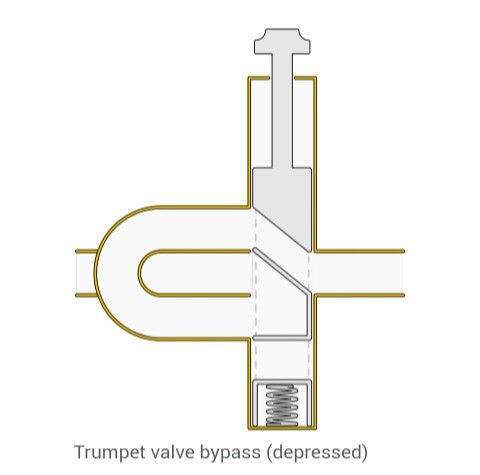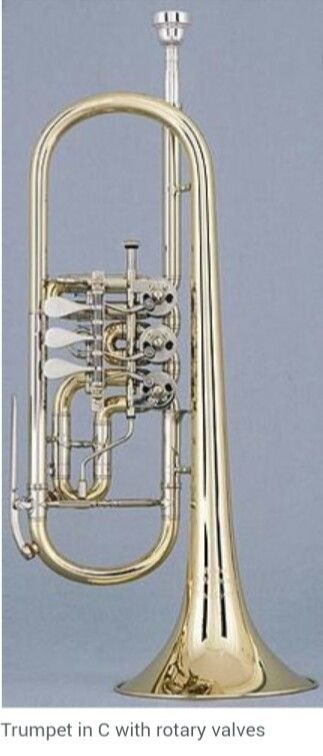The Trumpet- It's Construction and Types
CONSTRUCTION

The trumpet is constructed of brass tubing bent twice into a rounded oblong shape. As with all brass instruments, sound is produced by blowing air through closed lips, producing a "buzzing" sound into the mouthpiece and starting a standing wave vibration in the air column inside the trumpet. The player can select the pitch from a range of overtones or harmonics by changing the lip aperture and tension (known as the embouchure).
The mouthpiece has a circular rim, which provides a comfortable environment for the lips' vibration. Directly behind the rim is the cup, which channels the air into a much smaller opening (the back bore or shank) that tapers out slightly to match the diameter of the trumpet's lead pipe. The dimensions of these parts of the mouthpiece affect the timbre or quality of sound, the ease of playability, and player comfort. Generally, the wider and deeper the cup, the darker the sound and timbre.
Modern trumpets have three (or infrequently four) piston valves, each of which increases the length of tubing when engaged, thereby lowering the pitch. The first valve lowers the instrument's pitch by a whole step (2 semitones), the second valve by a half step (1 semitone), and the third valve by one-and-a-half steps (3 semitones). When a fourth valve is present, as with some piccolo trumpets, it usually lowers the pitch a perfect fourth (5 semitones). Used singly and in combination these valves make the instrument fully chromatic, i.e., able to play all twelve pitches of classical music. For more information about the different types of valves, see Brass instrument valves.
The pitch of the trumpet can be raised or lowered by the use of the tuning slide. Pulling the slide out lowers the pitch; pushing the slide in raises it. To overcome the problems of intonation and reduce the use of the slide, Renold Schilke designed the tuning-bell trumpet. Removing the usual brace between the bell and a valve body allows the use of a sliding bell; the player may then tune the horn with the bell while leaving the slide pushed in, or nearly so, thereby improving intonation and overall response.
A trumpet becomes a closed tube when the player presses it to the lips; therefore, the instrument only naturally produces every other overtone of the harmonic series. The shape of the bell makes the missing overtones audible. Most notes in the series are slightly out of tune and modern trumpets have slide mechanisms for the first and third valves with which the player can compensate by throwing (extending) or retracting one or both slides, using the left thumb and ring finger for the first and third valve slides respectively.
TYPES
The most common type is the B♭ trumpet, but A, C, D, E♭, E, low F, and G trumpets are also available. The C trumpet is most common in American orchestral playing, where it is used alongside the B♭ trumpet. Its slightly smaller size gives it a brighter sound, clearer projection, and crisper articulation. Orchestral trumpet players are adept at transposing music at sight, frequently playing music written for the A, B♭, D, E♭, E, or F trumpet on the C trumpet or B♭ trumpet.
The smallest trumpets are referred to as piccolo trumpets. The most common of these are built to play in both B♭ and A, with separate leadpipes for each key. The tubing in the B♭ piccolo trumpet is one-half the length of that in a standard B♭ trumpet. Piccolo trumpets in G, F and C are also manufactured, but are less common. Many players use a smaller mouthpiece on the piccolo trumpet, which requires a different sound production technique from the B♭ trumpet and can limit endurance. Almost all piccolo trumpets have four valves instead of the usual three — the fourth valve lowers the pitch, usually by a fourth, to assist in the playing of lower notes and to create alternate fingerings that facilitate certain trills. Maurice André, Håkan Hardenberger, David Mason, and Wynton Marsalis are some well-known trumpet players known for their additional virtuosity on the piccolo trumpet.

Trumpets pitched in the key of low G are also called sopranos, or soprano bugles, after their adaptation from military bugles. Traditionally used in drum and bugle corps, sopranos have featured both rotary valves and piston valves.
The bass trumpet is usually played by a trombone player, being at the same pitch. Bass trumpet is played with a shallower trombone mouthpiece, and music for it is written in treble clef. The most common keys for bass trumpets are C and B♭. Both C and B♭ bass trumpets are transposing instruments sounding an octave (C) or a major ninth (B♭) lower than written.
The modern slide trumpet is a B♭ trumpet that has a slide instead of valves. It is similar to a soprano trombone. The first slide trumpets emerged during the Renaissance, predating the modern trombone, and are the first attempts to increase chromaticism on the instrument. Slide trumpets were the first trumpets allowed in the Christian church.
The historical slide trumpet was probably first developed in the late 14th century for use in alta capella wind bands. Deriving from early straight trumpets, the Renaissance slide trumpet was essentially a natural trumpet with a sliding leadpipe. This single slide was rather awkward, as the entire corpus of the instrument moved, and the range of the slide was probably no more than a major third. Originals were probably pitched in D, to fit with shawms in D and G, probably at a typical pitch standard near A=466 Hz. As no known instruments from this period survive, the details—and even the existence—of a Renaissance slide trumpet is a matter of conjecture and debate among scholars.
Some slide trumpet designs saw use in England in the 18th century.
The pocket trumpet is a compact B♭ trumpet. The bell is usually smaller than a standard trumpet and the tubing is more tightly wound to reduce the instrument size without reducing the total tube length. Its design is not standardized, and the quality of various models varies greatly. It can have a tone quality and projection unique in the trumpet world: a warm sound and a voice-like articulation. Since many pocket trumpet models suffer from poor design as well as cheap and imprecise manufacturing, the intonation, tone color and dynamic range of such instruments are severely hindered. Professional-standard instruments are, however, available. While they are not a substitute for the full-sized instrument, they can be useful in certain contexts. The jazz musician Don Cherry was renowned for his playing of the pocket instrument.
The herald trumpet has an elongated bell extending far in front of the player, allowing a standard length of tubing from which a flag may be hung; the instrument is mostly used for ceremonial events such as parades and fanfares.
The 20th century saw some experimentation with the layout and construction of the trumpet, notably with the introduction of balanced action instruments (with forward set valves) by Selmer, Olds and King in the 1930s and 40s, and heavy reinforcements and geometry changes by Monette beginning in 1983. Monette also designed the Flumpet in 1989 for jazz musician Art Farmer. It is a hybrid instrument with elements of trumpet and flugelhorn, sharing the three piston valve design and with a pitch of B♭.
There are also rotary-valve, or German, trumpets (which are commonly used in professional European orchestras) as well as alto and Baroque trumpets.
The trumpet is often confused with its close relative the cornet, which has a more conical tubing shape compared to the trumpet's more cylindrical tube. This, along with additional bends in the cornet's tubing, gives the cornet a slightly mellower tone, but the instruments are otherwise nearly identical. They have the same length of tubing and, therefore, the same pitch, so music written for cornet and trumpet is interchangeable. Another relative, the flugelhorn, has tubing that is even more conical than that of the cornet, and an even richer tone. It is sometimes augmented with a fourth valve to improve the intonation of some lower notes.